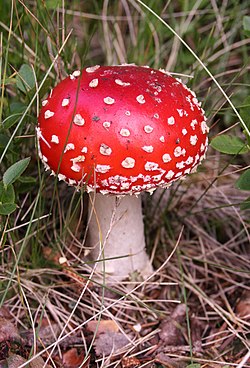
An agaric (/ˈæɡərɪk, əˈɡærɪk/) is a type of fungus fruiting body characterized by the presence of a pileus (cap) that is clearly differentiated from the stipe (stalk), with lamellae (gills) on the underside of the pileus. In the UK, agarics are called "mushrooms" or "toadstools". In North America they are typically called "gilled mushrooms".[1] "Agaric" can also refer to a basidiomycete species characterized by an agaric-type fruiting body.
Archaically, agaric meant 'tree-fungus' (after Latin agaricum); however, that changed with the Linnaean interpretation in 1753 when Linnaeus used the generic name Agaricus for gilled mushrooms.
Most species of agaricus belong to the order Agaricales in the subphylum Agaricomycotina. The exceptions, where agarics have evolved independently, feature largely in the orders Russulales, Boletales, Hymenochaetales, and several other groups of basidiomycetes. Old systems of classification placed all agarics in the Agaricales and some (mostly older) sources use "agarics" as the colloquial collective noun for the Agaricales. Contemporary sources now tend to use the term euagarics to refer to all agaric members of the Agaricales. "Agaric" is also sometimes used as a common name for members of the genus Agaricus, as well as for members of other genera; for example, Amanita muscaria is known by its common name "fly agaric".
References[edit]
External links[edit]
- "Gilled Mushrooms" at AmericanMushrooms.com
- "Evolution & Morphology in the Homobasidiomycetes" by Gary Lincoff & Michael Wood, MykoWeb.com
Well, that’s interesting to know that Psilotum nudum are known as whisk ferns. Psilotum nudum is the commoner species of the two. While the P. flaccidum is a rare species and is found in the tropical islands. Both the species are usually epiphytic in habit and grow upon tree ferns. These species may also be terrestrial and grow in humus or in the crevices of the rocks.
View the detailed Guide of Psilotum nudum: Detailed Study Of Psilotum Nudum (Whisk Fern), Classification, Anatomy, Reproduction